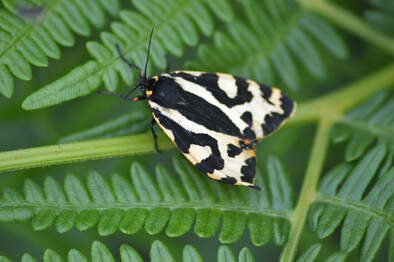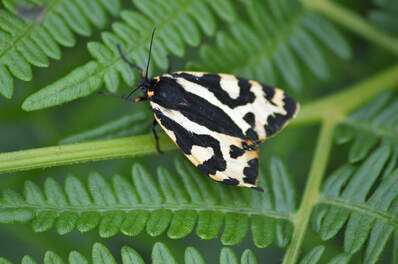Nectar and Moths
You may have noticed that many plants, like the high nectar-yielding Dandelion, as well as many popular none-native species like the African daisies (Osteospermum spp.) and the bindweed look-alike Convolvulus cneorum, close their flowers at night.
This means that their nectar is not available to the lepidopteran nightshift, namely the countless species of moths that must need it to fuel their flight - or do they? As they make up a significant part of the diet of bats, and supply the all-important abundance of caterpillars for nestling birds, moths are even more important to the food chain than butterflies.
It is clearly important therefore to sow a wide range of nectar plants and maintain and encourage pre-existing ones, at least some of which will keep their flowers open at night, or even, like honeysuckle, open them specially to welcome moths.
 Wood Tiger Moth
Wood Tiger Moth
A Starvation Diet
To overcome the problem of a shortage of winter and night-time nectar plants, some species of moth have adopted a rather extreme solution. Once they become adults they stop feeding. It is a relatively common phenomenon, but so few moths have been studied in detail that it’s hard to hazard a guess at just what proportion of species do this.
Among those that starve themselves are several widespread British moths. These include the Wood Tiger Moth, Oak Eggar and Goat Moth.
This means that throughout their adult lives they rely upon the food laid down as caterpillars to enable them to produce a large number of viable, full-sized eggs, and have the stamina to fly around in search of a mate and suitable food plants on which to lay their eggs. This emphasises the importance of a high quality diet for the caterpillars if the adults are to produce a healthy new generation.
This applies not only to those species of moth that take no external sustenance as adults. Butterflies do continue to feed but sugary nectar itself is far from constituting a balanced diet, so well-fed caterpillars are equally essential to produce a generation of strong healthy egg-laying adults. Even if its effects are not seen immediately, a sub-optimal diet over a few generations can impair the ability to reproduce and weaken the viability of a colony of moths or butterflies.
The importance of a rich supply of larval food plants cannot be emphasised too strongly. Butterflies, moths and many other insects start out as larvae and in order to develop into healthy adults depend on the leaves of specific wildflowers for their nutrition, the very wildflowers that fall victim to over-intensive agriculture, local authority strimmers and herbicide sprays, and the dismal paving over of gardens.
We need to ensure that the degradation of our environment is halted and reversed without delay.
To overcome the problem of a shortage of winter and night-time nectar plants, some species of moth have adopted a rather extreme solution. Once they become adults they stop feeding. It is a relatively common phenomenon, but so few moths have been studied in detail that it’s hard to hazard a guess at just what proportion of species do this.
Among those that starve themselves are several widespread British moths. These include the Wood Tiger Moth, Oak Eggar and Goat Moth.
This means that throughout their adult lives they rely upon the food laid down as caterpillars to enable them to produce a large number of viable, full-sized eggs, and have the stamina to fly around in search of a mate and suitable food plants on which to lay their eggs. This emphasises the importance of a high quality diet for the caterpillars if the adults are to produce a healthy new generation.
This applies not only to those species of moth that take no external sustenance as adults. Butterflies do continue to feed but sugary nectar itself is far from constituting a balanced diet, so well-fed caterpillars are equally essential to produce a generation of strong healthy egg-laying adults. Even if its effects are not seen immediately, a sub-optimal diet over a few generations can impair the ability to reproduce and weaken the viability of a colony of moths or butterflies.
The importance of a rich supply of larval food plants cannot be emphasised too strongly. Butterflies, moths and many other insects start out as larvae and in order to develop into healthy adults depend on the leaves of specific wildflowers for their nutrition, the very wildflowers that fall victim to over-intensive agriculture, local authority strimmers and herbicide sprays, and the dismal paving over of gardens.
We need to ensure that the degradation of our environment is halted and reversed without delay.
